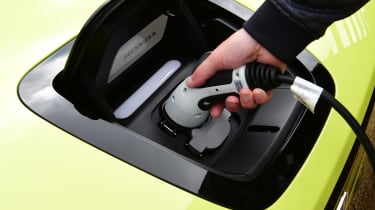Honda e hatchback review - Range, charging & running costs (2020-2024)
A shorter range than rivals but the Honda e has fast-charging as standard
The Honda e is expensive compared to its main rivals. There are cheaper electric cars that’ll go further on a single charge, and a recent price rise has meant the e no longer qualifies for the plug-in car grant. However, once you’ve signed to buy the car you’ll enjoy low running costs. Recharging costs a lot less than refilling with petrol, especially if you make use of cheaper overnight electricity tariffs, and road tax is currently free for EVs.
Residual values for electric cars are also much higher than they used to be, and we expect there will always be demand for the retro-styled Honda e. You should stand to get a good price for the car after three years but we won’t know exactly how much until the car has been on the road a little longer.
As is the case with all battery-powered cars, the quoted range is achieved in perfect conditions. Batteries don’t tend to work so well in colder weather, so you might find that you’re having to recharge more often during winter.
Honda e range and charging
Depending on whether you choose 16-inch or 17-inch alloy wheels, the Honda e will officially manage 137 or 125 miles between charges. The car won’t be suitable for drivers who do lots of motorway miles and the range may still put off some potential buyers who do a mix of town and motorway driving. There are several similarly priced EVs like the Renault ZOE which easily manage over 200 miles on a charge. Meanwhile, the MINI Electric and Mazda MX-30 both offer a similar figure to the Honda e.
More reviews
In-depth reviews
Most drivers will have to plug in regularly and the Honda e does offer charging flexibility. Fast-charging at up to 50kW is included, and recharging to 80% takes half an hour. If you charge on a 7.4kW Type 2 charger, topping up to fully charged takes a little over four hours, and you can also plug it in to a regular three-pin plug socket. Come back in just under 15 hours, and the car will be recharged again, so this is only really useful when there's no better alternative.
Taxing the Honda e is free for private customers, while company-car drivers will pay minimal Benefit-in-Kind (BiK) tax. As it’s an electric car, the Honda e is also exempt from congestion charges and London’s Ultra-Low Emissions Zone (ULEZ).
Insurance
The Honda e starts in insurance group 25. This increases to group 29 for the Advance trim level. This isn't drastically different from cars like the MINI Electric and Renault ZOE - the latter sits in groups 18-23.
Warranty
The Honda e should get the same three-year/90,000-mile warranty as Honda’s petrol, diesel and hybrid models. Honda offers a separate warranty for the battery, with eight years or 100,000 miles of cover for any failures, or if the battery drops below 70% of its original capacity.
Servicing
Electric cars have fewer moving parts than petrol or diesel engines, so their servicing should be cheaper. Your Honda dealer will be able to offer you a service plan to cover the car’s first couple of services, and you’ll be able to pay in one lump sum or in affordable monthly payments.










